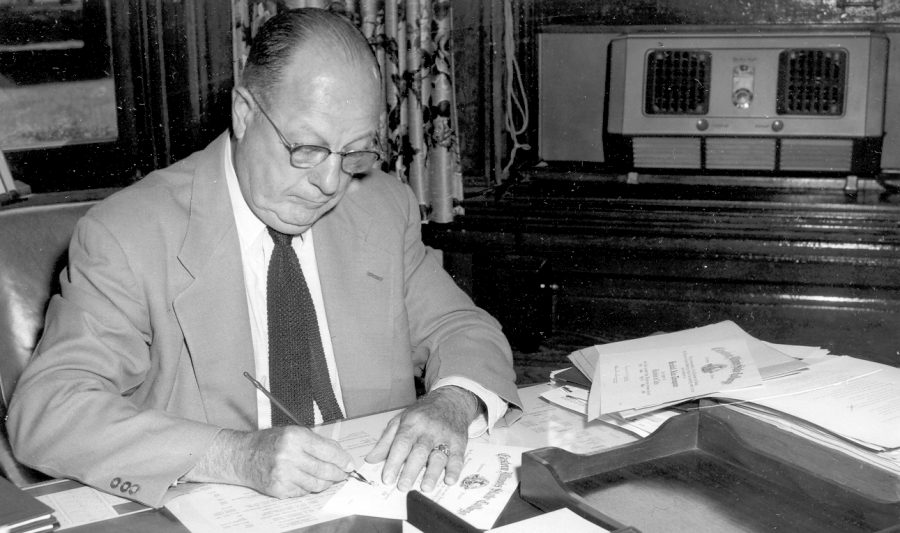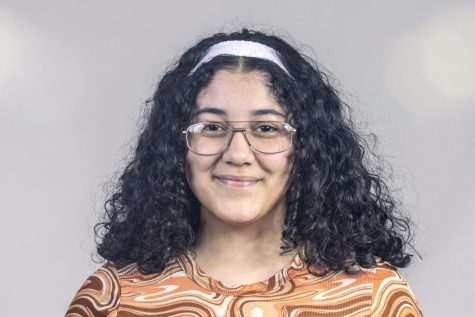Remembering former Eastern President Buzzard
PHOTO COURTESY OF THE KEEP Black and white photograph of President Robert Guy Buzzard, seated at his desk and signing diplomas. Date of photograph is approximate. Buzzard served as president of Eastern Illinois University from 1933 to 1956.
November 28, 2021
To Eastern students, faculty and staff, Buzzard is the building between the Tarble Arts Center and the Doudna Fine Arts Center, the building where students go to learn the skills they need for careers in education, communication and journalism.
This particular hall is named after Robert G. Buzzard, who, according to a 2006 Daily Eastern News story, “saw everything from conference championships in football, basketball and baseball to making a push for general education in the late ‘40s.”
Buzzard was Eastern’s third president and second sitting president, due to the university’s first president, Samuel M. Inglis, dying before officially assuming office. Buzzard served as president from 1933 to 1956.
Prior to being Eastern’s president, Buzzard taught for two years at Northern Illinois University and was the head of the department of geography-geology at Illinois State University from 1922 to 1933.
Buzzard’s history at Eastern began with his wife, Irene Couchman Buzzard. According to a 2006 Eastern press release, Couchman Buzzard graduated from a two-year course at Eastern in 1916, back when it was known as Eastern Illinois State Normal School.
Years later, the family moved to Charleston when Buzzard became president of the university.
“Charleston was their life, and Eastern Illinois University was certainly their life,” John Buzzard, the former president’s eldest son said in the press release.
According to a 2016 ForeverEIU history issue, with the arrival of Buzzard in 1933 “came campus expansion and beautification and a new vision for the institution.”
During his time as Eastern’s president, many changes happened to Eastern’s campus that helped the university move forward.
In 1934, Saturday classes were dropped and replaced with a Monday-through-Friday program. Also with the end of World War II in 1945, an overflow of students came to Eastern.
Buzzard’s vision for the university was for it to evolve from a teacher-training facility to one that also includes non-teaching degree programs.
In 1947, Eastern’s name changed to Eastern Illinois State College, and, according to the 2016 history issue, “Before Dr. Buzzard completed his tenure, Eastern was authorized to grant degrees in non-teaching fields.”
One of his objectives as president was for the university to grow by building new facilities.
In 1938, the Health Education Building was built and later renamed Lantz Gym in 1953 after Charles Lantz, who was the director of athletics at Eastern for 42 years.
Lantz Gym was later renamed to McAfee Gym in 1965 after Florence McAfee, the head of the women’s physical education program from 1935 to 1962. Residence halls, Lincoln and Douglas Hall, were also completed during his presidency.
The Physical Science Building and the then-under-construction Buzzard Hall were also built during Buzzard’s presidency.
According to a 2008 Eastern press release about Buzzard’s son, Charles Buzzard, donating to Booth Library a scrapbook compiled by the former president, Buzzard also oversaw the original construction of Booth Library from 1948 to 1950.
According to the press release, “the decision to build it so far south of campus was controversial.”
Allen Lanham, the dean of library services in 2008, said that in retrospect, the decision was brilliant, “as the campus has grown around the building, making it a central location.”
The press release also says that the ideals Buzzard stood for remain in place at Eastern today: “small class sizes, accessibility to education, and the importance of graduates going out and making their communities better places to live.”
“His vision was for a university that would serve southeastern Illinois … so that their children could grow up and have an education, because the way to grow is through education,” Charles Buzzard said. “The whole concept was he wanted southeastern Illinois to become a better place for families to live – all those little towns and the farms in between.”
Kyara Morales-Rodriguez can be reached at 581-2812 or [email protected]




















































